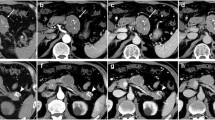Abstract
A solid pseudopapillary tumor (SPT) of the pancreas is a rare neoplasm that mainly occurs in young women. We herein report the case of a small SPT arising from the head of the pancreas in an asymptomatic 32-year-old man, plus a literature review of this tumor. A 32-year-old man was admitted to our department at Kumamoto University Hospital for the evaluation of a pancreatic mass. The tumor had central necrosis, which was poorly perfused on contrast-enhanced computed tomography (CT) and which had a high intensity on T2-weighted magnetic resonance imaging (MRI). Histology revealed the lesion to be a solid pseudopapillary tumor of the pancreas, with the characteristic pseudopapilla formation and central degeneration. However, no capsule formation was observed. The tumor was positive for CD56, CD10, α1-antitrypsin, α1-antichymotrypsin, β-catenin, and progesterone receptor. However, the tumor was negative for pancreatic hormones, chromogranin-A, carcinoembryonic antigen, and carbohydrate antigen 19–9. We diagnosed the patient to have an SPT based on these histological findings. Small-sized solid pseudopapillary tumors of the pancreas are being increasingly recognized because of the recent advances in CT and MRI. We should also consider SPT even if it occurs in a male when the tumor contains necrosis-suspected areas which are poorly perfused on contrast-enhanced CT with a high intensity on T2-weighted MRI.
Similar content being viewed by others
References
Tipton SG, Smyrk TC, Sarr MG, Thompson GB. Malignant potential of solid pseudopapillary neoplasm of the pancreas. Br J Surg 2006;93:733–737.
Kloppel G, Solcia E, Longnecker DS, Capella C, Sobin LH. Histological typing of tumors of the exocrine pancreas. 2nd ed. WHO international histological classification of tumors. Berlin Heidelberg New York: Springer; 1996.
Frantz VK. Tumors of the pancreas. In: Atlas of tumor pathology. Vol. 7 fascicle 27 and 28. Washington, DC: Armed Forces Institute of Pathology; 1959.
de Castro SM, Singhal D, Aronson DC, Busch OR, van Gulik TM, Obertop H, et al. Management of solid-pseudopapillary neoplasms of the pancreas: a comparison with standard pancreatic neoplasms. World J Surg 2007;31:1130–1135.
Papavramidis T, Papavramidis S. Solid pseudopapillary tumors of the pancreas: review of 718 patients reported in English literature. J Am Coll Surg 2005;200:965–972.
Balthazar E, Subramanyam B, Lefleur R, Barone CM. Solid and papillary epithelial neoplasm of the pancreas: radiographic, CT, sonographic, and angiographic features. Radiology 1984;150:39–40.
Buetow PC, Buck JL, Pantongrag-Brown L, Beck KG, Ros PR, Adair CF. Solid and papillary epithelial neoplasm of the pancreas: imaging-pathologic correlation on 56 cases. Radiology 1996;199:707–711.
Ohtomo K, Furui S, Onoue M, Okada Y, Kusano S, Shiga J, et al. Solid and papillary epithelial neoplasm of the pancreas: MR imaging and pathologic correlation. Radiology 1992;184:567–570.
Okino H, Ueda Y, Toyoda K. A case of solid cystic tumor of the pancreas (in Japanese with English abstract). Nippon Rinsyo Geka Gakkkai Zasshi (J Jpn Surg Assoc) 1997;58:196–201.
Buetow PC, Parrino TV, Buck JL, Brown LP, Ros PR, Dachman AH, et al. Islet cell tumors of the pancreas: pathologic imaging correlation among size, necrosis and cysts, calcification, malignant behavior, and functional status. AJR 1995;165:1175–1179.
Ekelman E, Stephens D, Ward E, Sheedy P. CT features of nonfunctioning islet cell carcinoma. AJR 1984;143:943–948.
Prokesch R, Chow LC, Beaulieu CF, Brammer R, Jeffrey RB. Isoattenuating pancreatic carcinoma at multi-detector row CT: secondary signs. Radiology 2002;224:764–768.
Uchimi K, Fujita N, Noda Y, Kobayashi G, Kimura K, Matsunaga A, et al. Solid cystic tumor of the pancreas: report of six cases and a review of the Japanese literature. J Gastroenterol 2002;37:972–980.
Pettinato G, Di Vizio D, Manivel JC, Pambuccian SE, Somma P, Insabato L. Solid-pseudopapillary tumor of the pancreas: a neoplasm with distinct and highly characteristic cytological features. Diagn Cytopathol 2002;27:325–334.
Okada K, Furuuchi T, Tamada T, Sasaki T, Suwa T, Shatari T, et al. Pancreatobiliary fistula associated with an intraductal papillarymucinous pancreatic neoplasm manifesting as obstructive jaundice: report of a case. Surg Today 2008;38:371–376.
Author information
Authors and Affiliations
Rights and permissions
About this article
Cite this article
Mima, K., Hirota, M., Abe, S. et al. Small solid pseudopapillary tumor of the pancreas in a 32-year-old man: Report of a case. Surg Today 40, 772–776 (2010). https://doi.org/10.1007/s00595-009-4139-x
Received:
Accepted:
Published:
Issue Date:
DOI: https://doi.org/10.1007/s00595-009-4139-x




